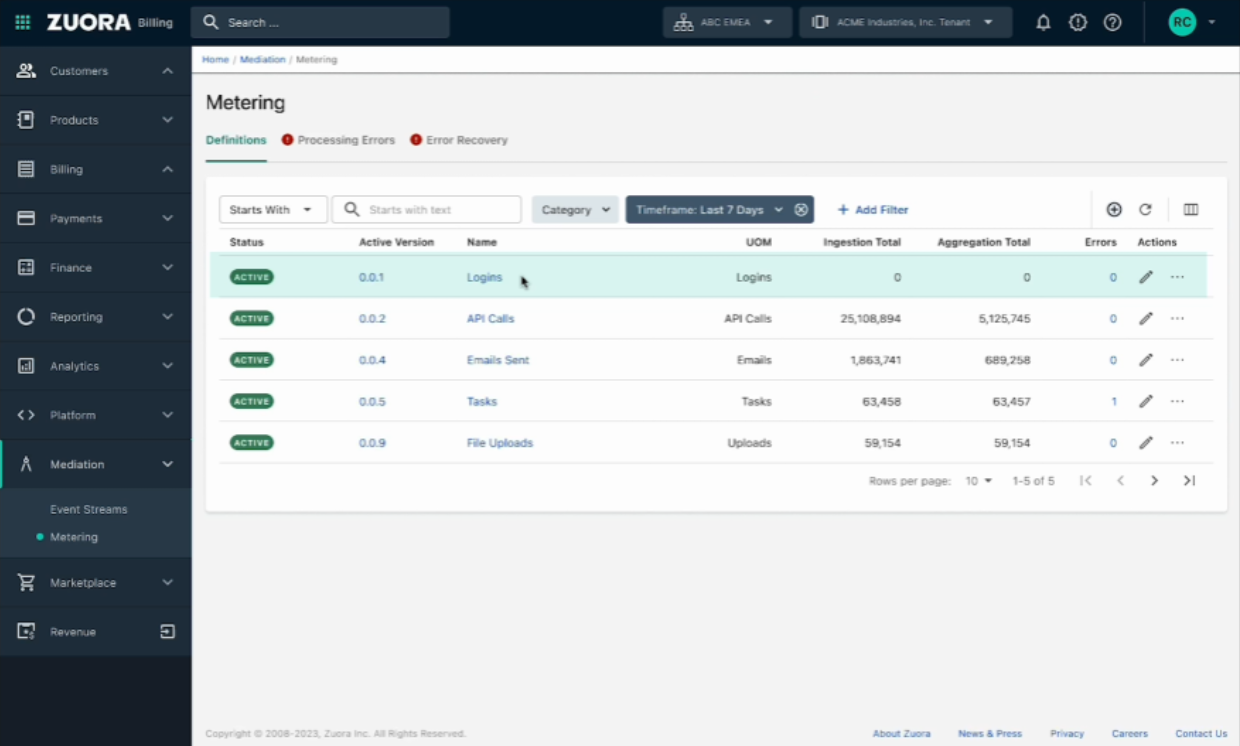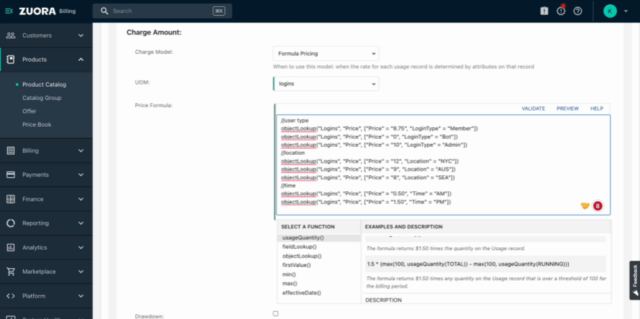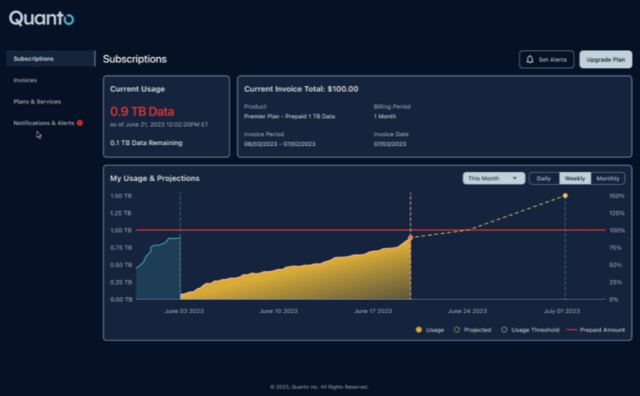Consumption pricing is the next big thing. Are you ready for it?
Over the past 15 years, we’ve worked with some of the best companies in the world. When it comes to consumption, we’ve seen what works, what the pitfalls can be, and where gaps in the market currently exist.
At our recent Subscribed Live event, Zuora CEO Tien Tzuo and I delved into what consumption pricing is, what happens when it goes wrong, and how Zuora is innovating to help companies quickly and easily adopt consumption pricing models.
Watch now: Stay customer-centric with consumption pricing
Introducing Zuora for Consumption
Businesses and consumers love the idea of consumption pricing, but very few companies have really nailed the execution – the approach is too often piece-mealed. We took a holistic approach with Zuora for Consumption, giving finance teams the right billing and revenue automation tools, customers the transparency and flexibility to consume what they want, and product owners the right pricing and mediation tools to pivot from pure pay-as-you go to hybrid models – and everything in between.
Keep reading for the top 3 reasons that Zuora for Consumption is the complete package.
1. Give product managers complete pricing flexibility
Some companies spend years setting up consumption pricing – they choose a pricing model, pivot their product strategy, change their entire go-to-market structure, and finally launch. Only to then discover that they got it wrong, right out of the gate. And now they’re stuck with a pricing model that’s all wrong for their business and customers and it’s going to take another year to iterate and pivot their consumption model to something different.
Zuora for Consumption features a native Mediation Engine and Consumption Pricing Designer, making it easy to craft a consumption pricing model to fit your needs right out of the box.
- Mediation Engine.1 Much like the electric meter on your house measures your power usage and turns it into billable kilowatt hours, our Mediation Engine meters and measures each of your predefined consumption attributes. All you have to do is select the attributes that make the most sense for your business. Examples include API calls, number of emails sent, tasks in an application, file uploads, or logins.

The more attributes you have to base your pricing on, the more you can create the perfect offering for your customers. And with drag and drop capabilities, our Mediation Engine turns what would otherwise be a very complex process, into something really easy to manage.
- Consumption Pricing Designer. Once you’ve defined your attributes, you need a consumption pricing strategy. Right out of the box, our Consumption Pricing Designer comes with over 50 built-in consumption models, such pay-as-you-go, minimum commitment, or pre-paid with drawdown. And coming this fall, Formula Pricing1 will give you the ultimate flexibility to use simple code to design your own consumption pricing model.

“We’ve highly leveraged the Zuora product catalog and easily extended it to set up different tiers, features, and consumption pricing models for our customers. Whether it’s offering new services or updating existing ones, we can update the catalog quickly without developer overhead. If we’re seeing higher customer demand in a certain market, we can quickly adjust prices to meet market demand.”
– Chaz Adams, Product Manager, Flexcar
Zuora customer update: What’s new in Zuora
2. Allow customers to have visibility into their usage
Surprises lead to terrible customer experiences. The nature of consumption pricing means that customers might not realize how much they’re using. We’ve all done it — you hit your phone data limits on the 5th day of the month, or your Wi-Fi on the plane runs out after just 45 minutes. Now you have to pay more and you wonder why this couldn’t have been prevented?
The answer is transparency – customers need to stay apprised of their consumption patterns. And if you can do it right, it’s not only a better experience, but can be a key growth lever as well. Customers like to see what they’re paying for, what they’ve used, and what their usage patterns are. Zuora’s Real-Time Rating Engine and Consumption APIs make this possible.
- Real-Time Rating Engine. Working behind the scenes, this engine continuously processes and rates consumption data in near real-time to provide visibility into consumption charges for customers, sales, and finance.
- Consumption APIs. When a customer reaches 90% of their plan, Zuora’s Consumption APIs send a threshold notification, ensuring proactive communication. Based on this customer’s previous consumption, Zuora is also able to provide an estimate of when they’ll hit their committed amount. Customers can then be presented with the option to upgrade their plan to avoid overage charges.

“With Zuora, we’ve implemented consumption in a variety of ways that provide immediate value, increasing flexibility for our customers while making revenue more predictable. By powering these models, Zuora is a critical partner that is helping us achieve stronger retention and faster growth.”
– Moshe Sarusi, Director of Finance Operations and Global Billing, Yotpo
Hear from a customer: Yotpo
3. Reduce complexity and headaches for finance
Giving customers the option to upgrade their plan mid-cycle is ultimately a win for both the customer and the business. But what does it mean for finance teams? Finance often has an aversion to consumption based pricing, because it introduces a whole host of new variables and revenue accounting is already extremely complicated as it is. Since consumption pricing is dependent on how customers consume the product, there’s a lot more dependency on data from the product team. Getting it wrong means failed audits and misstated revenue. The risks are high.
Zuora Revenue allows finance teams to automate and scale their operations to support consumption pricing models.
- ASC 606 and IFRS 15 compliance. Automatically comply with standards and requirements, such as performance obligations. Apply and configure revenue recognition policies for each revenue stream — allowing subscription, consumption, and one-time transactions to all be recognized differently. Revenue is automatically, continuously, and accurately recognized over the month.
- Continuous Revenue Recognition. Zuora is a revenue subledger that feeds into your accounting system, but it also does continuous revenue recognition to give you near real-time insight into your current revenue position without having to wait for the end of the period. We help you continuously close the books, so when you get to the end of the quarter a lot of the work has already been done and Finance teams can focus on closing the books even faster.

Related guide: Are unknowns holding you back from pursuing revenue automation?
Conclusion
The benefits of consumption based pricing are significant and the effort to get there requires an enterprise-wide focus on understanding and driving customer value. Coordinating capabilities around metering, iteration, automation, and engagement are the ingredients to creating a winning value proposition that will drive more growth, less churn, and greater lifetime value.
We’ve already made Zuora for Consumption available – we released charge models like Prepaid Credits, the Real-Time Rating Engine, and Consumption Revenue back in January. We will be adding new capabilities such as the Formula Pricing and the Mediation Engine in a few months. All of this gives your product managers flexibility, customers visibility into what they are consuming, and your finance team what they need to be fully empowered.
Learn more about how Zuora for Consumption makes all of this possible.
1 Mediation Engine and Formula Pricing will be available in late 2023.